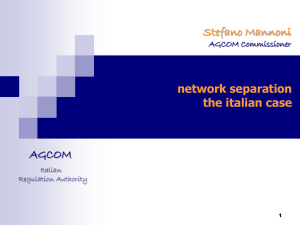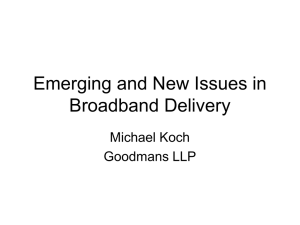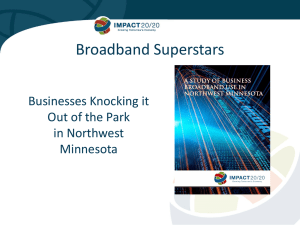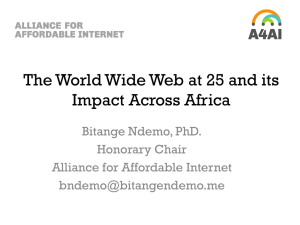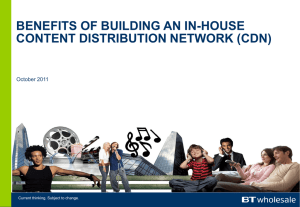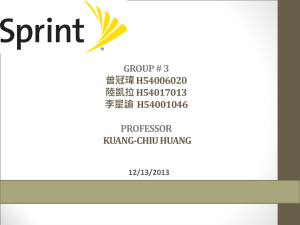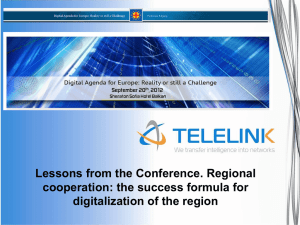a Brusasco - la Cabalesta
advertisement
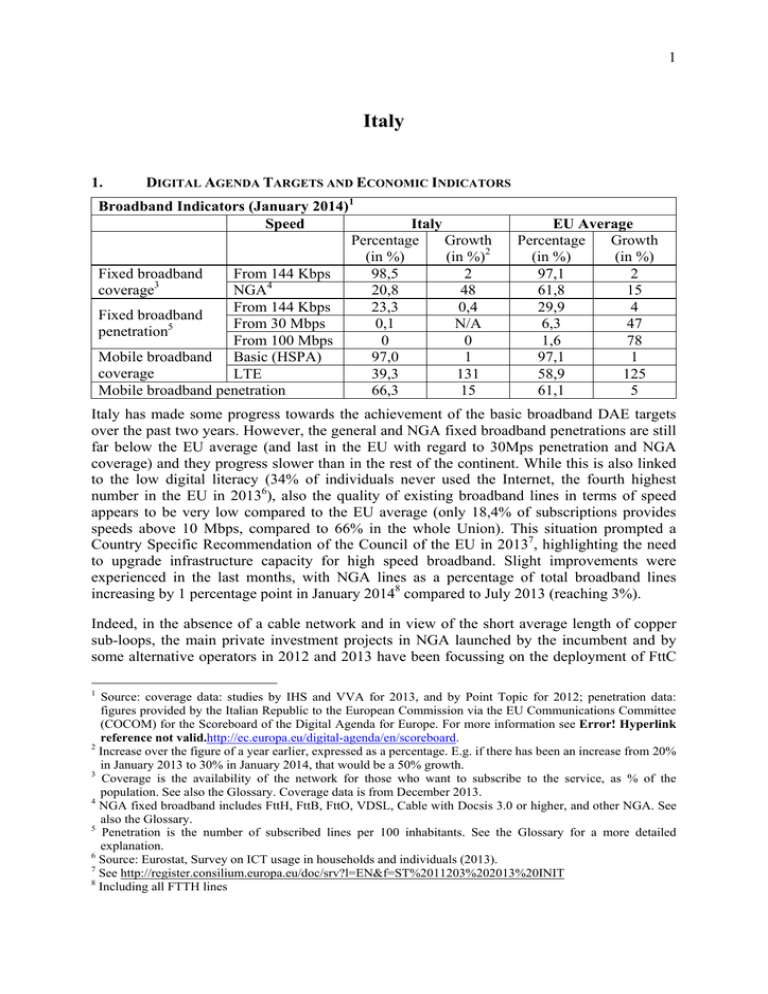
1 Italy 1. DIGITAL AGENDA TARGETS AND ECONOMIC INDICATORS Broadband Indicators (January 2014)1 Speed Italy Percentage Growth (in %) (in %)2 Fixed broadband From 144 Kbps 98,5 2 3 4 coverage NGA 20,8 48 From 144 Kbps 23,3 0,4 Fixed broadband From 30 Mbps 0,1 N/A 5 penetration From 100 Mbps 0 0 Mobile broadband Basic (HSPA) 97,0 1 coverage LTE 39,3 131 Mobile broadband penetration 66,3 15 EU Average Percentage Growth (in %) (in %) 97,1 2 61,8 15 29,9 4 6,3 47 1,6 78 97,1 1 58,9 125 61,1 5 Italy has made some progress towards the achievement of the basic broadband DAE targets over the past two years. However, the general and NGA fixed broadband penetrations are still far below the EU average (and last in the EU with regard to 30Mps penetration and NGA coverage) and they progress slower than in the rest of the continent. While this is also linked to the low digital literacy (34% of individuals never used the Internet, the fourth highest number in the EU in 20136), also the quality of existing broadband lines in terms of speed appears to be very low compared to the EU average (only 18,4% of subscriptions provides speeds above 10 Mbps, compared to 66% in the whole Union). This situation prompted a Country Specific Recommendation of the Council of the EU in 20137, highlighting the need to upgrade infrastructure capacity for high speed broadband. Slight improvements were experienced in the last months, with NGA lines as a percentage of total broadband lines increasing by 1 percentage point in January 20148 compared to July 2013 (reaching 3%). Indeed, in the absence of a cable network and in view of the short average length of copper sub-loops, the main private investment projects in NGA launched by the incumbent and by some alternative operators in 2012 and 2013 have been focussing on the deployment of FttC 1 Source: coverage data: studies by IHS and VVA for 2013, and by Point Topic for 2012; penetration data: figures provided by the Italian Republic to the European Commission via the EU Communications Committee (COCOM) for the Scoreboard of the Digital Agenda for Europe. For more information see Error! Hyperlink reference not valid.http://ec.europa.eu/digital-agenda/en/scoreboard. 2 Increase over the figure of a year earlier, expressed as a percentage. E.g. if there has been an increase from 20% in January 2013 to 30% in January 2014, that would be a 50% growth. 3 Coverage is the availability of the network for those who want to subscribe to the service, as % of the population. See also the Glossary. Coverage data is from December 2013. 4 NGA fixed broadband includes FttH, FttB, FttO, VDSL, Cable with Docsis 3.0 or higher, and other NGA. See also the Glossary. 5 Penetration is the number of subscribed lines per 100 inhabitants. See the Glossary for a more detailed explanation. 6 Source: Eurostat, Survey on ICT usage in households and individuals (2013). 7 See http://register.consilium.europa.eu/doc/srv?l=EN&f=ST%2011203%202013%20INIT 8 Including all FTTH lines 2 in the main cities, while in some urban areas of the North a dark-fibre operator deploys FttH in collaboration with municipalities. These developments have also been reported in the Italian Digital Agenda review released in January 2014. The review pointed out the feasibility of meeting the 30 Mbps coverage target by 2020. However, it also stressed the need to increase investments in networks and services for the 100 Mbps take-up target, in particular in order to enable e-government measures and their interoperability. Over the past two years, mobile broadband has continued to increase, reaching a penetration rate in January 2014 of double the one of 2011, and higher than the reported EU average. Alongside this, the deployment and commercial availability of LTE networks quickly progressed (more than tripled since July 2013), both in the main cities as well as in the areas in digital divide; in the latter case, this is fostered by the coverage obligations attached to each right of use for the 800MHz band, made available to the assignees as from 1 January 2013. 2. COMPETITIVENESS IN THE SECTOR Revenues and investment in the electronic communications sector 2010 2011 Revenues € 45,16 billion € 43,64 billion Growth N/A -3,4% Investment € 6,15 billion € 6,01 billion Growth N/A -2,3% 2012 € 40,98 billion -6,1% € 5,97 billion -0,6% In the context of an economic crisis, the revenues of the electronic communications sector continue to decline. This has also negatively impacted on investment, although to a lesser extent, in contrast with the average increase by 7,8% at EU level. With regard to revenues, the average revenue per user in mobile communications was €153, lower than the reported EU average of €187, also decreasing9. Reportedly, this is due to an ever-increasing diffusion of flat tariff plans, which are needed to compete with OTT voice and messaging services. 3. MARKET DEVELOPMENTS In the fixed broadband market, the incumbent Telecom Italia's market share kept on decreasing, from 53% in January 2012 to 51% in January 2013 and 50% in January 2014. In the fixed telephony market, the incumbent Telecom Italia remains the leading operator, but its market share for all national calls by traffic volume has decreased to 50,7% in December 2012, compared with 55,4% in December 2011 (-4,7 percentage points). The main technology used by new entrants is LLU (approximately 5,3 million lines), but also bitstream is relevant (approximately 1,8 million lines). In the mobile sector, the mobile penetration remained stable at very high level over the last two years (166%), sign that the market is now mature. The market share of the two main operators, holding approximately 1/3 of the market each, slightly decreased in favour of the other two MNOs while approximately 5% of the customer base is with the remaining 16 9 Referred to 2012. 3 MVNOs. Out of those from the MVNOs, two operators, including the biggest one, moved up on the ladder of investment, becoming full MVNOs, while another MVNO suddenly failed in early 2014. Taking also into account the high number of portability, it appears that quite dynamic competition takes place in this sector. In July 2013, the penetration rate of bundled offers (including mobile data and voice bundles) substantially increased, reaching 106% ratio subscription/population, representing an increase of 34 percentage points compared to the previous year. The double-play and triple-play penetrations were of 48,1% and 58,1% respectively. Bundles rarely include TV services, due to the lack of success of IPTV services as opposed to other kind of broadcasting platforms, such as digital terrestrial and satellite. On the other hand, Video-on-demand services via the internet are increasing (they are part of the latest commercial moves from the main content providers). 4. MARKET REGULATION A number of significant changes characterised the regulatory and economic environment over the past two years. While on the one hand these changes prompted adaptations of the regulatory framework, on the other hand the full implementation of such framework often required several regulatory decisions and interim regulatory measures in the meantime. Firstly, a decision concerning the remedies imposed on the SMP operator for fixed NGA networks was adopted in early 2012, but prices, geographical differentiation of remedies, symmetric obligations, vectoring required further specification by implementing measures. In this regard the framework decision, while deferring the development of a BU-LRIC model for NGA services to the analysis of access markets, provided a set of interim guidelines defining the price of NGA wholesale products (access to dark fibre, mini-tubes, VULA, NGA bitstream). These interim guidelines have been implemented with the approval of the Reference Offers for access services for years 2012 and 2013 (only the latter being notified to the Commission, in 2014). In this regard, the Commission issued several comments including one reminding AGCOM that prices, as an essential element of the price control obligation, should be made available to the Commission and that price levels and amendments to the methodologies used to calculate costs or prices, are considered to be material changes to the nature or scope of a remedy that have an appreciable impact on the market and should therefore be notified. Therefore, the Commission called on AGCOM to notify in the future any draft decision setting prices under Article 7 (3) of the Framework Directive. In addition, in view of the shift of investment plans of the incumbent and of some altnets towards FttC, the original guidelines on access to the cabinets for sub-loop unbundling (SLU), including measures concerning vectoring, have been detailed in the decision concerning LLU prices for 2013; furthermore, since February 2014 AGCOM launched a technical committee in order to specify the details of access to the cabinet, such as the new multi-operator cabinet technical specifications, the co-investment announcement mechanism and multi-operator vectoring. In the meantime a project for implementing functional separation of the incumbent’s network activities was presented in June 2013 and substantially amended by the incumbent itself in November 2013, with a view to creating an Equality of Input model without the need to implement a full societal separation of the network resources. Moreover, the Courts have 4 annulled certain aspects of the 2010 decision setting prices for LLU and related wholesale access products for years 2010-12. The overlapping of some of these events has implied significant delays, in particular in the adoption, still pending, of the third round of the analysis of markets 1, 4 and 5. This third round market analysis should indeed also incorporate the abovementioned follow-up measures for NGA networks. In view of such delay in the market analysis, considering that the 2010-2012 price cap fixed by the previous one expired and in order not to delay the annual price approval, AGCOM has adopted a bridging measure to set 2013 wholesale input prices (including LLU, SLU, bitstream and WLR, still widely used in Italy). Following to the notification of such measures in July 2013, the Commission opened a Phase II investigation pursuant to Article 7a of the Framework Directive. This procedure ended, after BEREC’s opinion,10 in December 2013, when the Commission adopted a specific Recommendation for Italy11 on the decision on wholesale input price for 2013, concerning in particular the methodology adopted for the calculation of weighted average cost of capital (WACC). Following this Commission recommendation, AGCOM has better specified in its final decision the WACC methodology calculation, although the final value of WACC remained substantially the same, and confirmed the notified copper LLU monthly fee of € 8,68. The final decision has been challenged by the incumbent operator and by an alternative operator specifically concerning the WACC value. With regard to mobile markets, in 2013, AGCOM concluded that the SMS wholesale termination market does not warrant ex ante regulation. The 2008 MTR decision was annulled by the court with regard to the extent of H3G’s asymmetry 2008-2009. Similarly, the 2011 MTR decision has also been annulled in March 2014 with regard to the elimination of asymmetry for the fourth operator as from July 2013, since the court did not consider justified this date in view of the different date for availability of frequency in the 900MHz band. In both cases therefore AGCOM will need to reassess the decisions. In 2014, the completion of an analysis of markets 1, 4 and 5 covering the period 2014-2016 is expected, with a view to also defining the remedies for NGA networks, including more detailed rules on multi-operator vectoring, and to finally provide a stable regulatory setting. The third round of Market 6 analysis has been launched at the end of 2013 and the fourth round of Market 7 has been launched at the beginning of 2014. 10 BEREC Opinion on Phase II investigation pursuant to Article 7a of Directive 2002/21/EC as amended by Directive 2009/140/EC: Cases IT/2013/1489-1490 Review of wholesale prices on markets 4 and 5 in Italy, available at http://berec.europa.eu/eng/document_register/subject_matter/berec/opinions/1473-berec-opinionon-phase-ii-investigation-pursuant-to-article-7a-of-directive-200221ec-as-amended-by-directive-2009140eccases-it20131489-1490-review-of-wholesale-prices-on-markets-4-and-5-in-italy 11 Commission Recommendation of 11.12.2013 in accordance with Article 7a of Directive 2002/21/EC in cases IT/2013/1489-1490: Details of the price control obligation in the markets for wholesale (physical) network infrastructure access (including shared or fully unbundled access) at fixed location and wholesale broadband access in Italy, C(2013)8862. 5 5. BROADBAND PLANS AND FINANCING Over the past years, Italy has implemented a national strategy for the extension of basic broadband (above 2 Mbps) to rural and isolated areas. This strategy encompassed € 1,1 billion of planned investments, mainly funded by means of National funds as well as structural funds projects of the Regions and European Agricultural Fund for Rural Development available for the period 2007-2013, redirected to broadband in 2011-2012. By January 2013, 46% of these projects, involving approximately 3,4 million inhabitants, were completed. On-going projects target 2,6 million inhabitants and should be completed in the next 18 months. In December 2012, the Ministry of Economic Development adopted a Strategic plan, designing a common framework for the granting of public funds by national and local authorities and regions for broadband investments in connection with the DAE objectives. This plan targets in particular NGA networks, through three investment models: i) direct public investment in passive networks, ii) Public Private Partership, and iii) grants complementing private investment projects. The Strategic Plan is not directly binding on the local entities, although several Regions entered into an agreement with the Ministry of Economic Development (and its in-house executive company, Infratel), for the coordination and implementation of interventions financed with their funds. In 2013, Infratel, awarded approximately € 126 million of public funds (European structural funds or regional funds), complementing private investments, for an overall amount of € 181 million of investments in white NGA areas in the region of Campania and € 5 million in white NGA areas in Molise. In the first quarter of 2014, Infratel Italia launched calls to award approximately € 127,6 million of public funds for investments in white NGA areas in Calabria, Puglia and some cities of Lombardia (Monza and Varese). 6. INSTITUTIONAL ISSUES 6.1. The National Regulatory Authority In July 2012, a new Head and four new Members of the Board were appointed to the independent NRA, AGCOM12. Their mandate lasts 7 years and is not renewable. The appointing authority cannot remove the members of the Board. AGCOM delivered in July its latest report to the national Parliament on its 2013 activities13. AGCOM is considering the adoption of an annual public plan of regulatory activities. AGCOM is vested with the ex ante regulatory tasks under the regulatory framework. It is in charge of ex ante regulation, sector specific consumer protection and spectrum as well as numbering planning; in addition to that, the authority is also competent for other sectors, such as audio-visual regulation and postal services. The Ministry of Economic Affairs14 (MiSE) is the governmental body with general policy competences and in charge of management of the general authorisation, assignment of individual rights of use for spectrum and numbers and international spectrum coordination. Moreover, from early 2014, in an attempt to address concerns raised by the Commission, the antitrust authority AGCM has been given exclusive 12 Autorità per le garanzie nelle comunicazioni. Available at http://www.agcom.it/Default.aspx?message=contenuto&DCId=5. 14 Ministero dello Sviluppo Economico. 13 6 competence for the implementation of general legislation on unfair commercial practices, including in the electronic communications sector15. Although the tasks are defined among the two NRAs and the antitrust and consumer protection authority, AGCM, there are still some areas where coordination could be improved (in particular between MiSE and AGCOM with regard to information on registered operators and spectrum management and planning, in particular in broadcasting; between AGCOM and AGCM on the enforcement of sector specific consumer protection rules vis à vis general unfair practices, taking into account that the existing cooperation protocol has not yet taken into account the abovementioned modification of competences concerning the application of general consumer protection rules). In December 2013, AGCOM and AGCM launched a joint sector enquiry on the impact of static and dynamic competition on broadband deployment in Italy, with a specific focus on NGA investments. In March 2013, AGCM finalised its 2010 investigation on the abuse of a dominant position by an incumbent in the provision of wholesale fixed services, resulting in a fine of approximately € 100 million. Another cartel case concerning price-fixing of ancillary services to LLU and maintenance, also involving the incumbent as a coordinator of the practice, has been opened and is currently on-going. In February 2013, the Commission started an infringement procedure regarding Italy’s compliance with the independence requirements of the NRA, with specific regard to legislative provisions imposing the unbundling of ancillary services. In May 2013, Italy amended the concerned legislation to empower AGCOM to adopt the appropriate measures, on the basis of the findings of a market analysis, and the case has therefore been closed. AGCOM has control over the spending of its budget, subject to the review by an internal commission appointed by AGCOM16 and the control by the Court of Auditors17. General financial spending review measures were applied to AGCOM as well as other national independent authorities. However, an opinion of the Supreme Administrative Court clarified that the savings stemming from these measures should be retained by the independent budget of AGCOM, rather than paid into the general budget. Despite clarifications from the European Court of Justice on the items that may be financed with administrative charges levied to electronic communications providers,18 national law extended up to 2016 the mandatory loan of AGCOM to some independent authorities. Following the mentioned ruling of the European Court of Justice, AGCOM did not apply the said provision for 2014, while AGCM started to pay back its 2010-2012 loan. Resources of the national regulatory authority19 2011 20 21 Personnel 354 15 2012 360 2013 353 Brought forward by Legislative Decree No 21 of 21 February 2014. Commissione di garanzia. 17 Corte dei Conti. 18 Case C-228/12. 19 The table only shows the results for AGCOM and include overall charges and costs due by all regulated undertakings, therefore including also content providers. 20 The figures include personnel seconded to other national or international institutions and do not consider part time positions.. 21 Data as of 31.12 of each year 16 7 Increase Budget (final balance) Increase/Decrease Administrative charges22 Administrative costs23 € 99,8 million +14,7%€ 76,4 million € 99,8 million [+1,6] % € 83,1 million -16,6 % € 79,7 million € 83,1million [-2,0] % [€ 83,2 million⃰ .a* [0 % n.a.*] € […] million n.a.* € […] million n.a.* * Final balance is not available at the moment, as 2013 budget is currently under approval. The budget's figure refers to the estimated provisional budget. Approximately 100 appeals were filed against AGCOM decisions at the first instance administrative tribunal24 in the last two years, including most of the important regulatory decisions. The final decision of a case at the level of the Supreme Administrative Court can take more than two years and it can cause significant delays when the appeal is upheld, as these rulings may require reassessment of the case. 6.2. Authorisation The Commission has looked into the implementation of the general authorisation regime, with regard to the administrative charges levied by the MiSE and the general authorisation for services provided on board of vessels. The Commission sent a letter of formal notice concerning the criteria for the application of administrative charges and the lack of transparency regarding administrative charges and administrative costs borne by the Ministry and financed by these charges, given that there is no transparency mechanism provided for in the law, unlike for the charges levied by AGCOM. 7. SPECTRUM MANAGEMENT By 1 January 2013, in line with the RSPP, Italy completed the authorisation process of the rights of use assigned in 2011 in the 800 MHz band, which is increasingly used for the provision of LTE. Italy has implemented a fund financed by the assignees of this band, with a view to addressing possible interference issues affecting end-users of digital broadcasting television. At the current stage of LTE deployment, however, interferences appear limited; moreover, the adjacent broadcasting channel (60 UHF) will gradually not be used any longer for TV. With regard to re-farming, the individual existing rights of use need to be modified by MiSE, at the request of the right holder, in order to allow for a neutral use of spectrum in accordance with the national allocation table. AGCOM has defined the conditions applicable to the refarming of existing rights of use, consisting in ensuring the safeguard of existing GSM users and realignment of fees with the latest assignments’ proceedings (in 2009 and 2011) for neutral use of the concerned bands. Some spare spectrum were not assigned in the bands 1800 MHz (2x5 MHz) as well as 2,6 (40 MHz) and 3,4-3,6 GHz (74 MHz), due to the limitations imposed by the Ministry of Defence. With regard to the frequency band 3,6-3,8 GHz, currently used for radio links, the process to clean this frequency band is in progress with the 22 In the sense of Art. 12 of the Authorisation Directive (Directive 2002/20/EC as amended by Directive 2009/140/EC). 23 Idem. 24 TAR Lazio. 8 aim to make the whole 3,4-3,8 GHz band compatible with use for LTE technology with multiple blocks of 5 MHz for backhauling links and for the realization of pico-cells in broadband mobile radio systems. While spare resources could be available for radio broadcasting in the MW band, the VHF and UHF frequency bands, including the lower part of the 700 MHz band, is fully used for digital radio and TV broadcasting. This has created serious interference problems with neighbouring countries, which are not able to fully use some of their GE06 allocated resources due to emissions from Italian local and national broadcasters. Following multilateral coordination facilitated by the EU Radio Spectrum Policy Group and correspondence with the European Commission, Italy has reorganized three national channels in 2013. Italy still needs to complete the implementation of some other measures agreed under the good offices of RSPG, to allow Malta to implement the Radio Spectrum Policy Programme and to address other ascertained interferences with Member States. In order to address this issue, a recently adopted national provision25 provides the funds to free the frequencies interfering with neighboring countries by means of economic compensation to the local broadcasters releasing these frequencies. In implementing this law, AGCOM is carrying out the procedures needed to identify the interfering stations and to exclude them from the terrestrial digital TV Plan. At the same time, secondary legislation is being drafted with a view to define the amount of compensation. The process of cleaning the spectrum is expected to be completed by 31 December 2014. Between the summer and the autumn of 2012, the final digital switch off of analogue terrestrial took place. The assignment of the additional digital multiplexes allowing access to frequency resources for new entrants and smaller operators has not yet been completed, although the call has been launched and the submission is under scrutiny with a view to complete the procedure in short time. This assignment aims at remedying the advantages that had been accrued to the incumbent operators through legislative means, which were considered by the European Commission to be contrary to EU law. Indeed the existing operators obtained in June 2012 a long-term right of use for up to the maximum duration allowed under national legislation in the same way of communication operators. Further, the biggest incumbents were granted the possibility to use a fifth multiplex for DVB-T transmissions without any conditions for remedying the long lasting infringement being applied. 8. RIGHTS OF WAY AND ACCESS TO PASSIVE INFRASTRUCTURE The procedures for granting rights of way are local, with different levels of complexity depending on the kind of infrastructure and the area concerned. Electronic submission of requests is available only in limited areas. Pursuant to the Decree-Law 179/2012, the Ministry of Economic Development and the Ministry of Infrastructure and Transport have established a Decree26defining common digging rules for the laying of fibre optic, with a view to favour the use of trenchless technologies (eco-friendly). 25 26 Law decree n°145/2013 converted into law 21th of February 2014. "Specifiche tecniche delle operazioni di scavo e ripristino per la posa di infrastrutture digitali nelle infrastrutture stradali" published in GU Serie Generale n.244 del 17 October 2013. 9 Significant uncertainty is caused by the delay in the implementation of other provisions of Decree Law 179/12 concerning the measurement of EMF limits. In the absence of implementing guidelines agreed with the Ministry of Environment and local environment agencies, local authorities contest the measures provided in this decree. This causes delays in the deployment of new LTE networks due to the reduction of the possibility of re-using existing sites. Access to telecom passive infrastructure is mandated on an asymmetric as well as a symmetric basis. As far as an asymmetric access is concerned, in 2012, in compliance with obligations imposed by AGCOM, the Italian incumbent published cost-oriented reference offers for access to civil infrastructures, dark fibre and optical in-building wiring. Reasonable symmetric access concerns only parts of the infrastructure and in particular in-house wiring and the backbone. There is a right to access other public utilities infrastructures, although limited to the backbone networks and the criteria for compensation are not clearly defined. Access to publicly financed works is provided. Coordination of civil infrastructure works is a task for the municipality. Municipalities are required to communicate planned civil works to the MiSE every 6 months. NGA wiring is not mandatory for new buildings, but recent provisions passed by the Parliament facilitate wiring interventions in jointly owned parts of the buildings. Moreover, according to Law 166/02, public utilities that build civil infrastructures (including buildings) have to equip them with ducts able to host optical fibre. In 2013, AGCOM adopted a symmetric access obligation for in-house wiring. 9. ACCESS AND INTERCONNECTION In 2012 and 2013, there were 52 new disputes concerning access obligations (mainly on origination of calls to non-geographical fixed numbers but also on margin squeeze, IP interconnection, and SMS termination), of which 46 settled. In November 2012, MiSE adopted IP interconnection standards. Since then the migration has started slowly, with the main AltNets having completed the experimental phase and 8 interconnection agreements being signed. Full IP migration could be completed by 2015. In order to stimulate the migration, as from July 2013 only an IP interconnection price, based on the more efficient IP interconnection architecture, applies, regardless of the technology used, with a price glide path that will end in July 2015. On the other hand, in order to avoid incumbent's behaviour aimed at delaying migration to IP, AGCOM has provided the possibility to impose an administrative migration, i.e. the interconnecting AltNet can apply the same conditions as applicable if the migration was completed. 10. CONSUMERS ISSUES 10.1. The European emergency number 112 Italy has not adopted an implementing legislation laying down caller location accuracy and reliability criteria. More generally, the implementation of measures to ensure equivalent access to emergency services for disabled users and to provide advanced Public Safety Answering Points’ services requires coordination of scarce resources with other emergency 10 services, handled at national or regional level. At the moment, only one region has implemented a common PSAP for all emergency services. 10.2. Number portability Portability continues to occur very frequently, for both mobile and fixed communications. Regarding mobile services, a sudden failure of a MVNO has created a major but isolated event of loss of services; AGCOM has imposed extraordinary measures in order to facilitate the migration of the affected customers to other networks. Regarding fixed communications, the establishment of a single database is still under discussion, with a view to reducing refusal of portability requests due to purely formal mistakes. 10.3. Contractual obligations AGCOM is investigating the charges that are due in case of termination of the end-user's contract, in order to assess whether they reflect the actual costs encountered when deactivating the service. 10.4. Other consumer issues The most common sources of complaints for fixed services concern the loss of service in the context of number portability and the charges billed. The latter is also the subject of most complaints in the mobile sector, in addition to the activation of services that have not been requested. Consumers have access to an efficient system of resolution and remedies to deal with electronic communications disputes. AGCOM, its local delegates the CoReCom’s, and the consumers’ associations’ chartered mediation, together are able to process a very high number of complaints. In 2012-13 they processed approximately 150 000 complaints. 11. UNIVERSAL SERVICE Since the transposition in 2012 of the 2009 review of the Regulatory Framework27, the scope of universal service does not include directory and directory enquiries services, subject to periodic review of the Ministry. Judicial challenges concerning the decisions on the incumbent’s net cost for universal service provision between 1999 and 2006 to be funded by operators' contributions have still not been settled. The latest available assessment, for 2007, did not recognise any net cost for the incumbent. AGCOM is also considering a different method for the designation of a universal service provider, instead of the current ex lege temporary designation of the incumbent. 12. NET NEUTRALITY 12.1. Legislative situation Italy did not adopt any legislative measures specifically regulating net neutrality. 27 See D. Lgs 28 May 2012 n. 70 and n. 69. 11 However, AGCOM regularly monitors the traffic management measures adopted by the fixed and mobile operators and imposed information and transparency measures over a number of them (traffic prioritization, traffic shaping, VoIP blocking, peer-to-peer traffic throttling, etc). Moreover, ISP should indicate for all Internet offers, in their advertising as well as in the web sites, the guaranteed minimum speed and not only the advertised maximum theoretical speed. 12.2. Quality of service AGCOM is very active in monitoring the quality of service in the sector, in particular with regard to specific aspects such as internet speed, but also other parameters, including the quality of post-sale assistance. Users have access to a tool certified by AGCOM to test the actual speed of their fixed connection, also in view of legal actions (www.misurainternet.it). AGCOM also checks the quality of data connections (including mobile) across the national territory, with an observatory for Quality of Service of Internet access, which uses dedicated measurement equipment. The goal is to provide both end users and the regulator with comparable and understandable quantitative data that give a fair and broad view of each ISP’s performance for all access technologies available (xDSL, cable and FttH). As from April 2014, moreover, users can directly file complaints for breach of the minimum guaranteed speed by their provider, including the certified measurement of connection, through the AGCOM website. AGCOM also conducts regular drive tests to measure the performance of mobile Internet 2G and 3G connections since 2013, with publication of comparative results. 4G tests are planned as from 2015 when at least two out of four operators are expected to cover more than 50% of the population. AGCOM is also promoting the implementation of an interactive system, web based, available to end users which will integrate both a tool showing the commercial coverage of fixedwireless-mobile broadband access and a new price comparison tool (in addition to the existing accreditation scheme).
